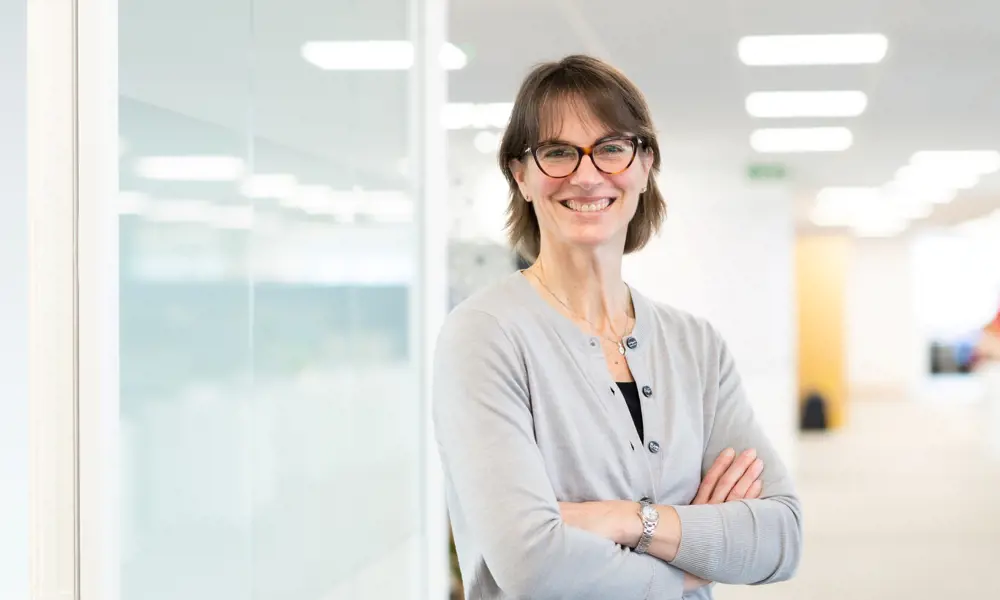
On the fast track to green hydrogen
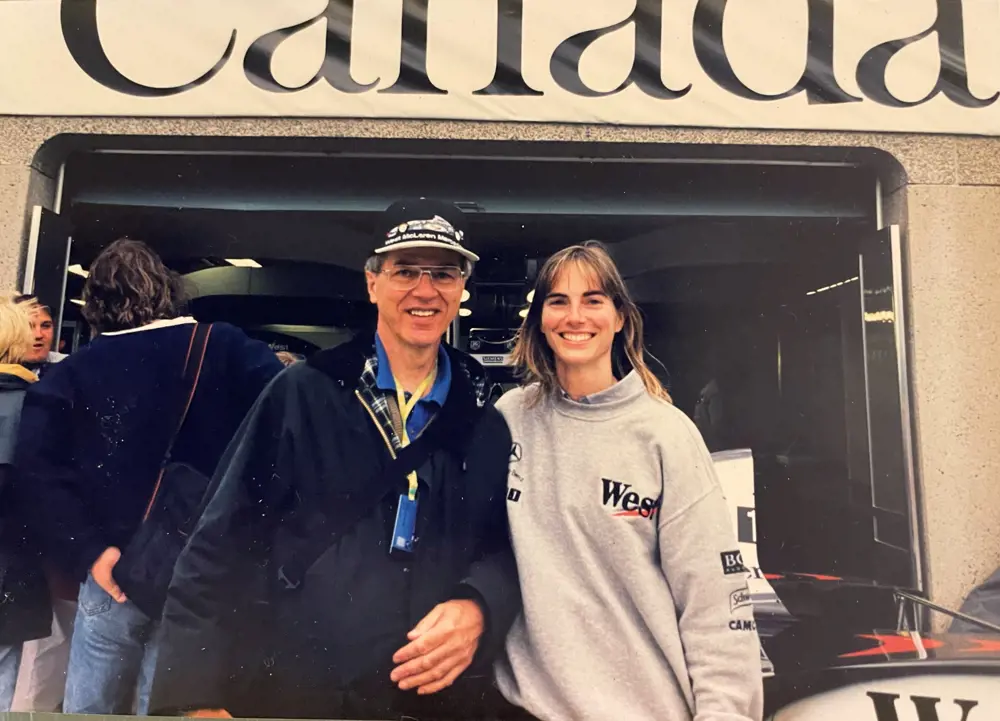
Caroline with her father at the Montreal Grand Prix in 1998 © Caroline Hargrove
A plan to study language helped to steer Dr Caroline Hargrove CBE FREng into an engineering career: “I grew up speaking French and wanted to learn English.” Studying maths and physics at school in francophone Montreal in Canada, she applied for a bursary for a summer school to study English. She recalls: “It was a lottery, a name picked out of a bag, and I got one.” When she arrived for the course at Queen’s University, Hargrove was so taken by the scenic campus on Lake Ontario that she decided that it would be a good place to be an undergraduate.
Hargrove had no clear career ambitions. “I didn’t know anything about engineering. There were no engineers in my family and schools were terrible at telling you what engineering is going to be like.” When she scanned the university’s list of courses, her eyes alighted on a degree in maths and engineering. “I thought, ‘That’s keeping options open’,” she says.
After completing her degree, Hargrove wanted to spend time in Europe. “As Canadians you get the opportunity to apply for Commonwealth graduate scholarships to study in the UK, and I got one.”
This took her to the University of Cambridge and an applied mechanics PhD in computer modelling of granular materials. Simply solving equations isn’t enough to understand these complex, multibody systems – think of solid particles able to flow, such as sand: “You’ve got to start doing all of these approximations and localised ways of modelling.” Hargrove worked on ways of looking at whole systems through the assumptions about what happens at small scale.
I didn’t know anything about engineering. There were no engineers in my family and schools were terrible at telling you what engineering is going to be like.
Dr Caroline Hargrove CBE FREng
Developing the first computer simulations for Formula 1
More fun than working on the car itself 🏎️
Caroline Hargrove admits to being a sports nut and an aspiring gymnast in her youth, but she had no ambition to work in motor racing. Her expertise in computer modelling proved to be eminently transferable when she moved from the University of Cambridge to McLaren. There she continued work on modelling started by a colleague she had worked with during her PhD.
At first, expectations were low. The idea was to model ideas before trying them in cars. “Twenty-odd years ago, it was really slow to run models. So we wrote everything from first principles,” she explains. “We derived the full set of differential equations on paper.” They then encoded them to run more quickly. “We realised that it was so fast that with a bit more optimisation we could do it in real time.” They then started the simulator programme.
Drivers and old-school engineers were doubtful. “It’s not going to work for Formula 1,” was the sentiment. Hargrove reckons that this scepticism took the pressure off them. No one was screaming that it had to work for the next race. Working on the model, she adds, “was more fun than actually working on the car itself. Because no one had built one of those before.”
Eventually they got to the stage where they would never put anything on a car unless it had already been modelled. “It got driver approval earlier than I thought. Because it was definitely not a favourite of the drivers at the beginning.”
Hargrove admits that at the start the simulators weren’t very good. “The drivers kept saying that their video games were better. But over time, the underlying technologies like the graphics cards got better and so did our simulators.”
The simulators turned out to be a revelation. “We realised there were loads of really fascinating insight that the drivers were picking out when they were driving the simulator and it was really valuable feedback for developing the car.”
She has said that F1 engineering feels very privileged “because it’s like working on big toys”. Nothing stands still, in more ways than one. From the beginning of a season to the end of the season, the cars are about 80% different.
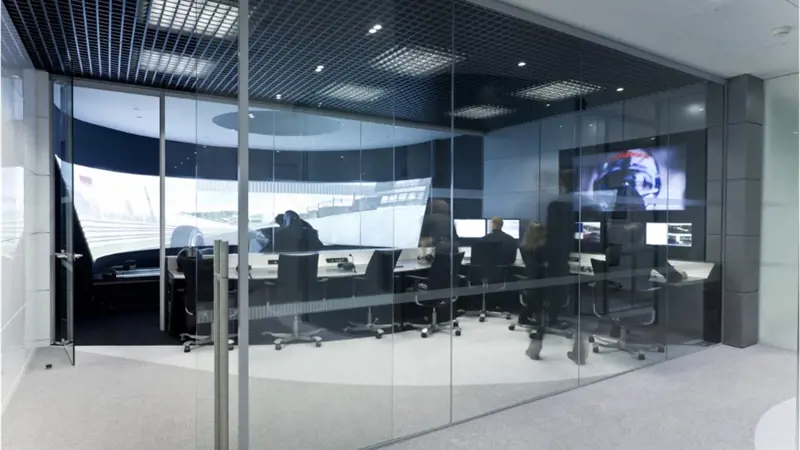
© McLaren Applied Technologies
That PhD led to a research fellowship and then a lectureship at Cambridge. “I enjoyed it very much,” she insists. But after four years, she decided that she just had to work in industry. “It’s the problem-solving more than the research that drives me.”
Hargrove’s move into industry involved one of the coincidences that she credits with guiding her career. She responded to a magazine advert from the McLaren Formula 1 racing team seeking someone to work on modelling. Her CV landed on the desk of an engineer at McLaren she had worked with during her PhD. As Hargrove recounts it, his response was “Oh, I know, she can do this”. “So, I got the job.”
At McLaren, Hargrove applied the computer modelling that had fuelled her PhD. With the Formula 1 team, her work progressed from trying out design ideas to developing simulators of racing cars in action [see ‘Race track models’].
Beyond F1
After 10 years in racing, Hargrove was one of three engineers asked to set up McLaren Applied Technologies, a technology consultancy to capitalise on work done for McLaren’s racing team. In the new business, sports remained in the picture. The launch of the new business was before the 2012 London Olympics. Various sports teams turned to McLaren for help. “I got a lot of stick at the start because I really wanted to work with UK Sport but it wasn’t commercially attractive.” After a bit of an internal tussle, they were given the go ahead “with the proviso that we weren’t going to talk about it, unless it ultimately led to success for Team GB”. She ended up working mostly with the cycling team. “They were already a lot like a Formula 1 team. They were very data driven. They knew what they wanted, and it was straightforward for us to support them.”
In 2012 at McLaren Applied Technologies, Caroline ended up working mostly with the GB Olympic cycling team. “They were already a lot like a Formula 1 team. They were very data driven. They knew what they wanted, and it was straightforward for us to support them.”
Quick Q&A
An island library 📚
What inspired you to become an engineer?
My love of problem-solving.
Favourite project you worked on?
I have to say Ceres, because we have the potential to be one of the cornerstone clean energy technologies in the world.
What are you are most proud of?
I am most proud of the simulator we built at McLaren because it was a first and truly groundbreaking at that time.
Who influenced your engineering career?
My PhD supervisor, Professor David Newland.
What’s your advice to budding engineers?
Keep questioning the status quo.
Best part of the job now?
Working with a great team on a common mission.
Which record/book would you take to a desert island?
I can’t answer that, I love reading and could never settle for just one book!
Hargrove’s work with McLaren Applied Technologies turned towards applying Formula 1 principles to health and medicine. This meant using sensors and data processing, and inferring as much as possible when you can’t directly measure. For example, one medtech project involved working with drug companies to monitor patients on clinical trials. McLaren’s engineers monitored biomarkers with few ethical issues, such as heart rate and activity level. “If you’re on a drug trial and your activity level goes down dramatically, that’s never good. So, it’s a proxy for overall health benefits.”
The technology group’s commercial work also included optimising design and manufacturing. “That’s mostly how we brought in revenue. Finding long-term solutions that other people would then fully implement.” An odd spinoff from racing cars, you would have thought. “100%. I could not believe how useful we were, doing this. When you think, surely they know this inside out already, way more than we do.”
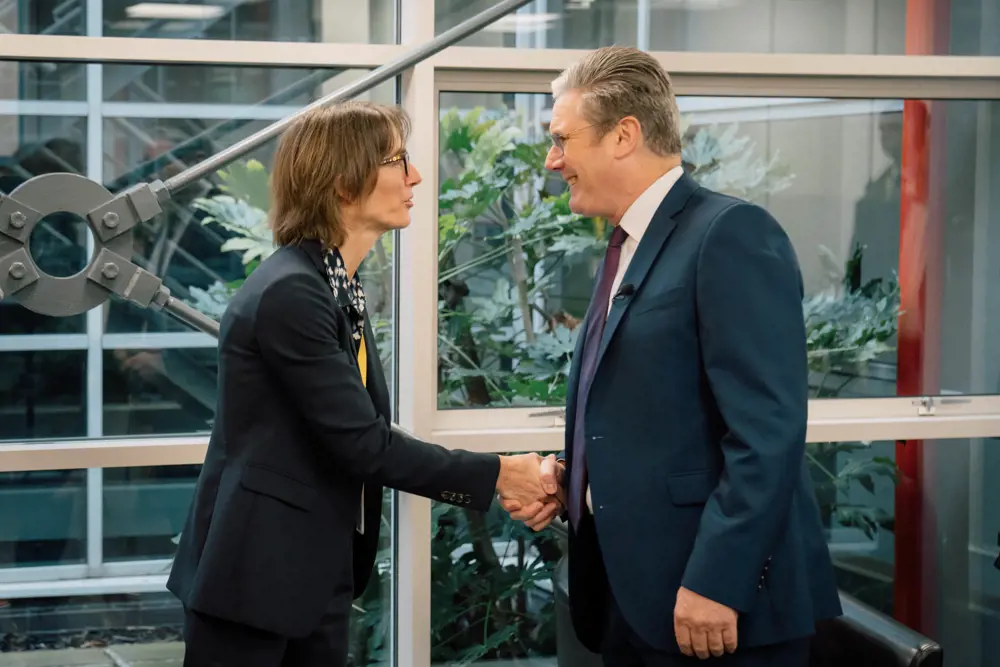
Caroline welcoming Sir Keir Starmer to Ceres Power’s Manufacturing Innovation Centre in Redhill © Ceres Power
Pivoting to cleantech
After 20 years with McLaren, and rising to be CTO of McLaren Applied Technologies, Hargrove was becoming less happy about how things were going in the business, which had grown to more than about 600 engineers. Rather than staying on and complaining, or making a bid to run the business, she looked for new opportunities. Running the business wasn’t for Hargrove. “I like the technical side. And that’s what gets me up in the morning.”
A fresh opportunity came in a chance encounter at a dinner with the COO of Babylon, a medtech scale-up company. “They wanted to use more AI and simulation to essentially keep people out of hospital, but also [be] your GP in your pocket.” This was pre-COVID-19. While the pandemic threw the light on the need for such technology, it also meant that people were so focused on the virus that it became difficult to do anything else. Throw in the CEO’s decision to move Babylon to the US, a much bigger playground for developing AI in medicine, and Hargrove faced new decisions. Not sure that the technology was market ready, she was looking for interesting engineering challenges.
Running the business wasn’t for Hargrove. “I like the technical side. And that’s what gets me up in the morning.”
Hargrove had already decided that she would like a deeper understanding of how businesses work. “Doing consultancy-type gigs, you’re exposed to quite a lot, but it wasn’t the same as understanding how a public company was run.” As she puts it, if you want to help technology startups that plan to go public, you need to understand the constraints on listed companies. Someone suggested that she could do this as a non-executive director of a publicly quoted company, where her technical expertise would be valuable. Again, a chance conversation led her to Ceres, a business that developed electrochemistry in the pursuit of net zero through fuel cells and creating green hydrogen.
For Hargrove, the company had two attractions, it was a listed business that she could observe in action, and it was in cleantech. Ceres had been through some ups and downs since spinning out of Imperial College London in 2001, and Hargrove still saw it as a startup, albeit in its teenage years. As it happened, after COVID-19, the Chief Technology Officer wanted to take stock and do something different. As a board member, Hargrove was naturally involved in finding a replacement when the idea came up that she could take on the CTO role.
“Great question,” she laughs when asked to define what the CTO does at Ceres. She is there, she explains, “to steer people with common goals. Half of my job is to make sure that we have enough ideas being developed in the R&D space to improve our technology, at the fundamental level. Because what we do at Ceres is quite fundamental level electrochemistry. The other half is to ensure that it works. It has to be economically viable. It has to last – to be robust and have enough life – and be manufacturable at scale.”
Fundamental science
Ceres operates on a blend of fundamental science and usable technology. “These two sides need to work together, because we’re a technology licensing company. Unless you keep innovating at the lowest TRL [technology readiness level], we won’t be in business for very long.”
Hargrove has been CTO at Ceres during a change in direction. Until recently it focused on developing fuel cells built around its proprietary technology. The idea was that fuel cells would play a critical part in decarbonising power. Although Ceres’ technology is fuel flexible and can run on natural gas as well as hydrogen, there is ultimately a greater need for a reliable source of green hydrogen.
As Hargrove explains it, without a thriving “hydrogen economy” there won’t be as much demand for fuel cells. Currently, the most widely used approaches for creating hydrogen start with fossil fuels, generating carbon emissions that must be captured to keep out of the atmosphere. So, the company decided to focus on creating a greener hydrogen economy.
Ceres confirmed that its fuel-cell electrochemistry could work in reverse, in electrolysis mode. The business is now increasingly focused on engineering electrolysers that can produce green hydrogen, using electricity from renewable sources to split steam into hydrogen and oxygen. This is a way to generate hydrogen, without the carbon load of other approaches. The company’s achievements in the area earned it the prestigious MacRobert Award in 2023.
As Hargrove sees it, there isn’t a simple answer to achieving net zero. “We’re not trying to say hydrogen is a solution for everything. We’re saying, in industrial processes where you need hydrogen to decarbonise them, let’s do this with green hydrogen, because we start on this today.”
Hargrove also challenges politicians not to dither on net zero, pointing out that if you truly want to eliminate CO₂, you shouldn’t hand out permits for oil exploration, and instead set targets to get carbon out of the picture. “We should do things like give ourselves a target of no more grey or brown hydrogen.”
Career timeline and distinctions
Achieved a first class honours degree in an applied maths and mechanical engineering, 1989. PhD at the University of Cambridge in mechanical engineering, 1993. Fellow, Director of Studies and lecturer in engineering, Sidney Sussex College, Cambridge, 1994–1997. Vehicle dynamics and simulation engineer, McLaren Racing (F1 team), 1997–2007. Programme Director, McLaren Applied Technologies, 2007–2012. Technical Director and subsequently CTO, McLaren Applied Technologies, 2013–2018. Visiting Professor, Nuffield Department of Surgery, University of Oxford, 2015–2018. Fellow, Royal Academy of Engineering, 2017. Joined Ceres Power as Non-Executive Director, 2018. CTO, Vice President AI technologies, Babylon Health, 2018–2021. Appointed a Commander of the Order of the British Empire, 2020. Chief Technology Officer, Ceres Power, 2021–present.
Hargrove is critical of the UK’s lukewarm support for technologies like theirs that exist to build knowledge rather than factories that employ thousands of people. “We’re not a favourite for receiving grant funding. When you’re a licensing company, you don’t build big factories that provide jobs. It annoys me because we do provide new jobs that are actually really high-value jobs. I get a bit cross,” she says, with an emphasis on when politicians think they should only support industries that manufacture in the UK. “Yeah, but the R&D done by industries in the UK is also excellent.” And it depends on the work of a lot of bright scientists and engineers.” Those are desirable jobs being created.
Why don’t government initiatives like IP generators? “It’s frustrating because, as a license model, we have a poster child [in the UK]. We have ARM. It’s an inspiration for other startups.”
Hargrove also challenges politicians not to dither on net zero, pointing out that if you truly want to eliminate CO2, you shouldn’t hand out permits for oil exploration, and instead set targets to get carbon out of the picture. “We should do things like give ourselves a target of no more grey or brown hydrogen.” She suggests setting 2040 as a target, for example, so that companies will take note and investment will follow, instead of saying how it should happen. “It shouldn’t be ‘we want more electrolysis’. It should be ‘we don’t want any more hydrogen molecules made from fossil fuels’.”
Hargrove recently went back to Queen’s University to collect an honorary degree from her alma mater. “I never thought this would happen. I was so touched and humbled,” Hargrove said of the honour. Talking to the next generation of engineers, she said: “What I am hoping is the technology we are developing will decarbonise the hard-to-decarbonise industries such as steel and cement. That’s a tough sector where you can really have an impact. If we can decarbonise those industries significantly, that is going to be amazing.”
Contributors
Michael Kenward OBE
Author
Keep up-to-date with Ingenia for free
SubscribeRelated content
Mechanical
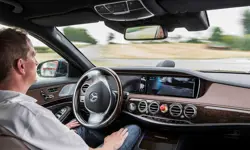
When will cars drive themselves?
There are many claims made about the progress of autonomous vehicles and their imminent arrival on UK roads. What progress has been made and how have measures that have already been implemented increased automation?

R&D investment makes good business sense
In just five years, Dr Ralf Speth FREng has presided over a revolution in design and manufacturing that has helped create a new family of engines and has overhauled Jaguar Land Rover (JLR) production facilities.
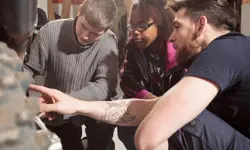
Bikes help improve skills and attitude
The Archway Project is an independently-funded scheme that is expanding its engineering-based programmes by providing BTEC certificates and diplomas. John Milton, the director of the project, explains what the charity does to help reduce anti-social behaviour and improve employment prospects.

High speed evolution
In December 2010, Eurostar International Ltd awarded a contract for 10 new high speed trains to Siemens. The company has used a system developed over decades to maximise the performance and passenger-carrying ability of its 320km/h trains.
Other content from Ingenia
Quick read

- Environment & sustainability
- Opinion
A young engineer’s perspective on the good, the bad and the ugly of COP27

- Environment & sustainability
- Issue 95
How do we pay for net zero technologies?
Quick read

- Transport
- Mechanical
- How I got here
Electrifying trains and STEMAZING outreach

- Civil & structural
- Environment & sustainability
- Issue 95